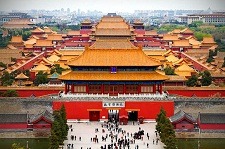
Forbidden City (故宫 or 紫禁城) where twenty-four emperors reigned over the country for over 500 years during the mid-Ming and the Qing dynasties, also named Palace Museum,The Forbidden City is the most magnificent and splendid palace complex in China and one of the five world-famous palaces with the Palace of Versailles in France, Buckingham Palace in England, the White House in the U.S. and the Kremlin in Russia. Today, the Forbidden City is one of the China’s most famous tourist attractions.
Why is it called the Forbidden City?
Forbidden City also called Purple Forbidden City. In the feudal society, emperors had supreme power, so this residence was certainly a forbidden place. Purple was the symbolic color of the North Star, which was believed to be the center of the cosmos. So it got the name of Forbidden City or Purple Forbidden City.
History of the Palace Museum
The site of the Forbidden City was part of the Imperial city during the Mongol Yuan Dynasty. Upon the establishment of the Ming Dynasty, the Hongwu Emperor moved the capital from Beijing in the north to Nanjing in the south, and ordered that the Mongol palaces be razed. When his son Zhu Di became the Yongle Emperor, he moved the capital to Beijing, and construction began in 1406 of what would become the Forbidden City.
Construction lasted 15 years, and required more than a million workers. Material used include whole logs of precious Phoebe zhennan wood found in the jungles of south-western China, and large blocks of marble from quarries near Beijing. The floors of major halls were paved with “golden bricks”, specially baked paving bricks from Suzhou.
From 1420 to 1644, the Forbidden City was the seat of the Ming Dynasty. In April 1644, it was captured by rebel forces led by Li Zicheng, who proclaimed himself emperor of the Shun Dynasty. He soon fled before the combined armies of former Ming general Wu Sangui and Manchu forces, setting fire to parts of the Forbidden City in the process. By October, the Manchus had achieved supremacy in northern China, and a ceremony was held at the Forbidden City to proclaim the young Shunzhi Emperor as ruler of all China under the Qing Dynasty.
In 1860, during the Second Opium War, Anglo-French forces took control of the Forbidden City and occupied it until the end of the war. In 1900 Empress Dowager Cixi fled from the Forbidden City during the Boxer Rebellion, leaving it to be occupied by forces of the treaty powers until the following year.
In 1912, Puyi, the last Emperor of China, abdicated. Puyi sold many treasures to finance his expensive lifestyle, while others were stolen by palace eunuchs. Under an agreement with the new Republic of China government, Puyi remained in the Inner Court, while the Outer Court was given over to public use, until he was evicted after a coup in 1924. The Palace Museum was then established in the Forbidden City. In 1933, the Japanese invasion of China forced the evacuation of the national treasures in the Forbidden City. Part of the collection was returned at the end of World War II, but the other part was evacuated to Taiwan in 1947 under orders by Chiang Kai-shek, whose Kuomintang was losing the Chinese Civil War. This relatively small but high quality collection was kept in storage for many years since the KMT still hoped to return to the mainland. Finally, in 1965, they again became public, at the core of the National Palace Museum in Taipei.
The East Glorious Gate under renovation as part of the 19-year restoration process.After the establishment of the People’s Republic of China in 1949, some damage was done to the Forbidden City as the country was swept up in revolutionary zeal. During the Cultural Revolution, however, further destruction was prevented when Premier Zhou Enlai sent an army battalion to guard the city.
The Forbidden City was declared a World Heritage Site in 1987 by UNESCO as the “Imperial Palace of the Ming and Qing Dynasties”, due to its significant place in the development of Chinese architecture and culture.
In recent years, the presence of commercial enterprises in the Forbidden City has become controversial. A Starbucks store, which opened in 2000, sparked objections and eventually closed on July 13, 2007. Chinese media also took notice of a pair of souvenir shops that refused to admit Chinese citizens in order to price-gouge foreign customers in 2006.
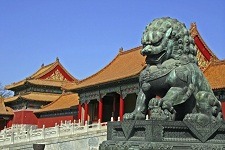
Construction of the Forbidden City
The Forbidden City occupies 720,000 square meters. There are 9,999 rooms in this series of exquisite palaces inside the City. Nine is a lucky number for the Chinese. The walls are 32 feet high. The surrounding drainage moat is 165 feet wide. The main part of the city was constructed over 14 years (1407-1420) using 200,000 laborers. Building materials were shipped over thousands of miles from all parts of China using the network of canals constructed in the 6th and 7th centuries.
All of the buildings are made from painted wood. To deal with the fire risk, giant bronze cauldrons filled with water were placed at intervals throughout the Palace.
Life in the Forbidden City
At the end of the 18th century approximately 9000 people lived within the Forbidden City, composed of guards, servants, eunuchs, concubines, civil servants and the Royal Family.
The inner sanctum rooms were forbidden to women except to the Empress on her wedding day. The tradition of castrating male servants dates back over two thousand years. The Qing Dynasty started with 9000 eunuchs, reducing to about 1500 in 1908. Their testicles were mummified and stored in jars, to be buried with them after their death. Many eunuchs were harshly treated, or executed at whim. Corruption, power struggles and personal vendettas flourished.
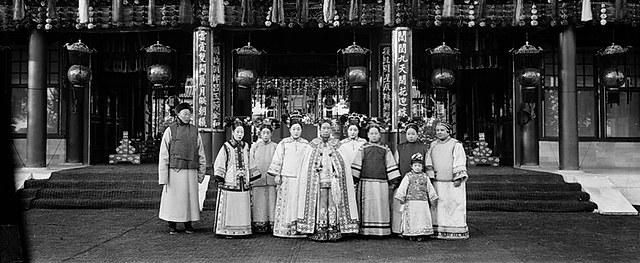
Emperors were entitled to several wives and many concubines. (Qianlong had two official wives and 29 concubines). Concubines were well-educated women selected from the best Manchu families. Nightly, the Emperor would decide which concubine would visit him that evening. She would then be stripped, bathed and dilapidated before being carried to his chamber. The number of times a concubine was chosen secured her social standing.
Depending upon status, each rank would dine from “color-coded” plates, cups and bowls. Only the Emperor and Empress were entitled to use real gold or “radiant yellow” porcelain. Over 3000 pieces of gold and silver plate were held in Qing kitchens during the 18th century.
The Emperor’s choice of successor was usually kept secret until after his death, when it was verified by bringing together a document held by the emperor with a document previously concealed in a sealed box.
Ministers and officials had to prostrate themselves on the floor before reporting to the Emperor.
Manchu women did not bind their feet, but wore shoes mounted on six- to eight-inch platforms, giving them the tottering gait considered seductive.
Instead of jousting with lances, Chinese courtiers took part in the competitive sport of poetry composition.
Portraits have a special significance in China because of the widespread practice of ancestor worship.
“The Last Emperor”, familiarly known as Puyi, succeeded to the throne at the age of three. He was forced to abdicate in February 1912, but was held in the Forbidden City until 1924. During those years he had a British tutor, Reginald Johnston, who gave him his first bicycle.
Virtual Guide
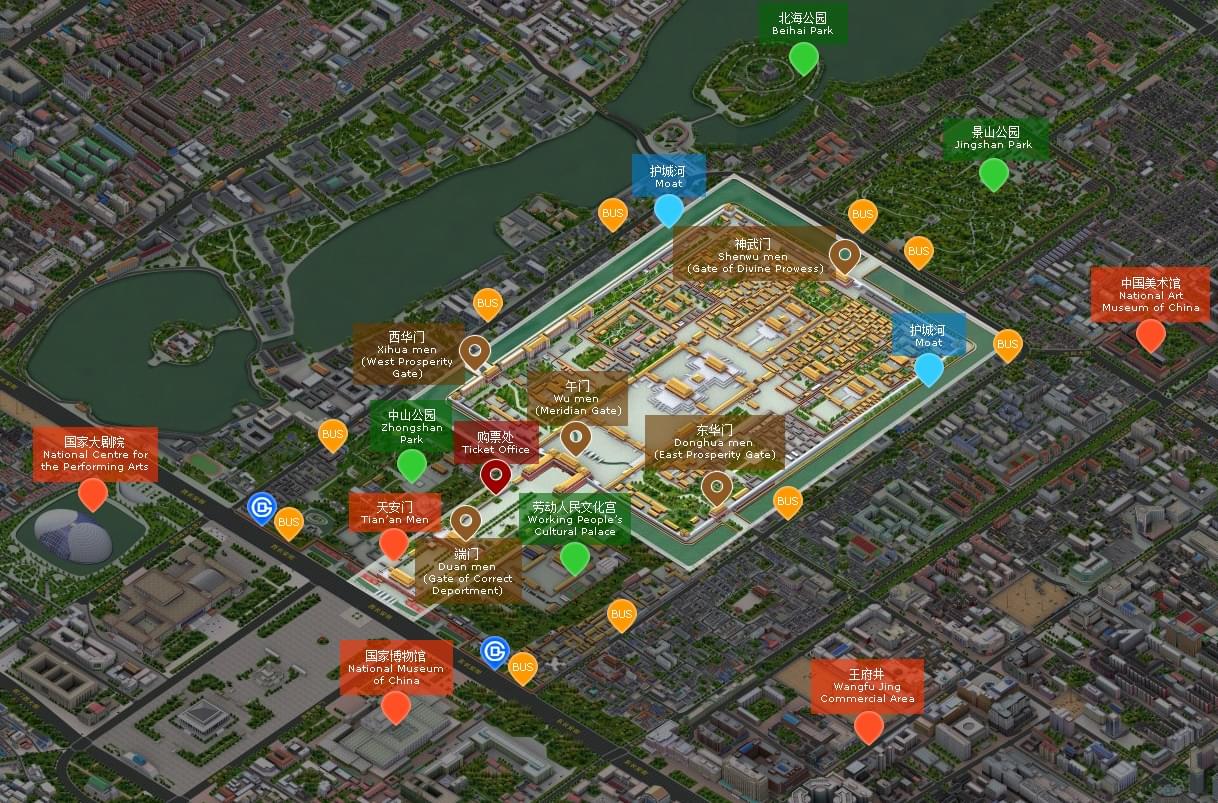
Route: Wu Men – Golden Water Bridges – Outer Court – Inner Court – Imperial Garden – Shenwu Men
Meridian Gate (Wu Men)
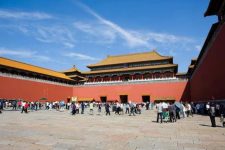
Meridian Gate (Wu Men) is the main gate and the south gate of the Forbidden City. Five Pavilions with golden glazed tiles, like five phoenixes, are connected with the gate, thus the gate is also called Five-Phoenix Pavilion. It has five entrances, each of which used to allow entry to people with certain rank. In feudal dynasties, the entrance in the middle was reserved for emperors and other four entrances were used by ministers.
Golden Water Bridges
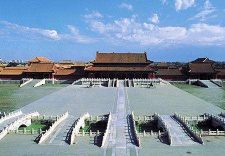
There is a river that curves like an arch in front of the Gate of Supreme Harmony (Taihe Men). The river is called the Inner Golden Water, the banks of which are decorated with balusters made of white marble. The Golden Water Bridges refer to the five white bridges on this section of the river. In the past, only emperors could cross the river via the middle bridge, which is the longest and widest. The other four were for government officials and imperial clansmen to pass. Surrounded by the red walls and golden tiles, the exquisitely carved white bridges look simple but elegant.
Outer Court
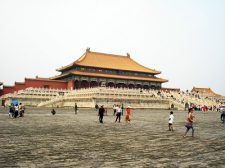
Gate of Supreme Harmony – Hall of Supreme Harmony – Hall of Central Harmony – Hall of Preserving Harmony
After walking through the Gate of Supreme Harmony, we come to the most fascinating part of the palace: the Outer Court. This court contains three main halls: Taihe Dian (Hall of Supreme Harmony), Zhonghe Dian (Hall of Central Harmony), and Baohe Dian (Hall of Preserving Harmony). The Hall of Supreme Harmony is the largest hall in the Forbidden City where grand ceremonies were held. The throne, windows, doors and poles inside are carved with dragon designs. The floor is covered with golden bricks that are of fine quality. At the back of the Hall of Supreme Harmony is the Hall of Central Harmony where emperors had a short rest and practiced the required etiquette before ceremonies. In the Hall of Preserving Harmony, banquets were held on New Year’s Eve. The west and east wing halls of the Hall of Preserving Harmony have been changed into galleries for art and clocks.
Inner Court
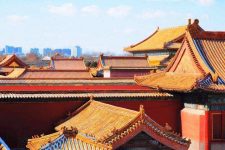
Gate of Heavenly Purity – Hall of Heavenly Purity – Hall of Union and Peace – Hall of Earthly Tranquility. Stepping through into the Outer Court again, you will see the Qianqin Men (Gate of Heavenly Purity) that is the front door to the Inner Court. The court is mainly the residence of the emperors, empress and other concubines, and other members of the royal family. It centers on the Qianqing Gong (Hall of Heavenly Purity), Jiaotai Dian (Hall of Union and Peace) and Kunning Gong (Hall of Earthly Tranquility). The three halls in order are flanked by the Six Eastern Palaces and Six Western Palaces and the Imperial Garden to the north, with studies, gardens, and pavilions scattered.
On the way to the Hall of Heavenly Purity, you will pass the west wing halls of the Hall of Heavenly Purity that used to be the studies of the emperors and princes. Now, the halls are used as the Pottery Gallery and the Bronze Gallery. The Hall of Heavenly Purity was where the emperor resided and handled routine government affairs. The Hall of Union and Peace was the place to celebrate the birthday of the empress and lay the seals of the country. The empress dwelled in the Hall of Earthly Tranquility. The rooms on the east were the bridal chamber which is arranged exactly as it was during the marriage period of Emperor Guangxu, an emperor of the Qing Dynasty. Other major halls are the Hall of Mental Cultivation, the Pavilion of the Rain of Flowers and the Palace of Benevolent Tranquility on the west.
Imperial Garden
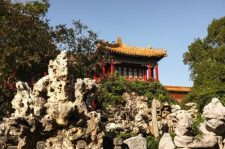
The delicate Imperial Garden is to the north of the Hall of Earthly Tranquility where members of the royal family amused themselves. There are evergreen cypress trees, rarely-seen flowers and trees, and pavilions in the quaint garden. The Wanchun Pavilion and the Qianqiu Pavilion are very luxuriant.
Shenwu Men (Gate of Divine Might)

The Gate of Divine Might is the north gate of both the ImperialGarden and the Forbidden City. You can start your visit from this gate, which is at the back of the Forbidden City. As we have mentioned before, the palace has four gates, with the other two being the Xihua Men and the Donghua Men, but the Wu Men and the Shenwu Men serve as entrances now.
Opening Hours
April 1st—October 31 8:30—17:00 Last Entry at 16:10 Tickets sold until 16:00
November 1st—March 31 8:30—16:30 Last Entry at 15:40 Tickets sold until 15:30
Ticket
From November 1 through March 31, admission is CNY40
From April 1 through October 31, admission is CNY60
The Forbidden City limits the daily number of visitors to 80,000, and we recommend individual visitors book tickets in advance online at https://gugong.ktmtech.cn/ (only Chinese version available). Foreign visitors are required to provide passport numbers and full names when book tickets online. For details, visit http://en.dpm.org.cn/visit/tickets/.
If you do not have online reservation, please visit the site in the morning, there are usually tickets available in the morning.
Notes
1. Treasure Gallery and Clock Gallery require a separate ticket of CNY10 respectively.
2. Children under 120 cm in height are free of charge.
3. Tickets of CNY20 are available for elementary, middle school and university students with student identity card or certified letter from the school (including students from Hong Kong, Macau, and Taiwan, excluding graduate and adult education students).
Service
Audio guides in Mandarin, Cantonese, English, French, German, Japanese, Korean, Portuguese, Italian, Arabic, Russian, Spanish, and Thai are available at the Meridian Gate (Wu men) and the Gate of Divine Prowess (Shenwu men). The deposit is CNY100 for each. The rental fee is CNY40 for each, except the Mandarin guide which is CNY10. Please return the audio guide before exiting.
Services include package check (Meridian gate, Wumen), gift shops, bookstores, refreshments and light meals, an Information Center in the Archery Pavilion (Jian ting), public address system.
Forbidden City Tours
We arrange seat-in-coach guided tour to Forbidden City:
- Forbidden City, Temple of Heaven and Summer Palace tour – USD38/person
- Forbidden City and Mutianyu Great Wall tour – USD40/person
- Half day Forbidden City Tour – USD30

